Post by oldcyansilverback on Jan 17, 2023 14:47:05 GMT -5
Lesser Yellow-headed Vulture
Cathartes burrovianus
Accipitriforme Order – Cathartidae Family
BIOMETRICS:
Length: 58-66 cm
Wingspan: 160 cm
Weight: 950-1550 g
DESCRIPTION:
This species is also called Savanna Vulture, and belongs to the New World vultures.
The Lesser Yellow-headed Vulture adult has blackish plumage overall, with some glossy blue-green feathers on the upperwing and distinct white area at base of the six outer primaries, forming strong contrasts against the black plumage. This pale area is due to the white quills.
Wings are long and broad and at rest, they appear longer than the tail which is relatively long and rounded.
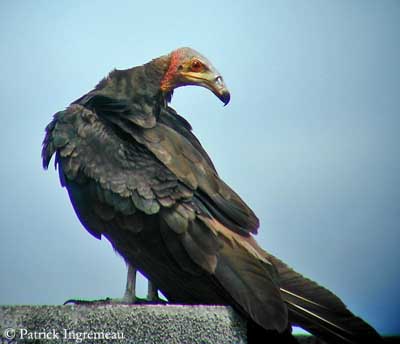
Head and neck are bare and their colours may vary. Some birds have bright yellow bare skin, but others may also have orange and blue tones. Usually, forecrown and nape are reddish, whereas central crown is blue-grey. The skin often has warty aspect, especially on neck, nape and head sides.
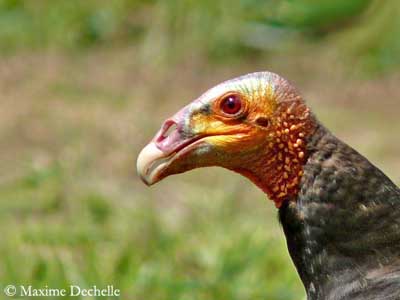
The hooked bill is pale flesh to whitish with pale pink cere. Eyes are red. Legs and feet are pale greyish-white. The large nostrils allow a highly developed sense of smell in these raptors.
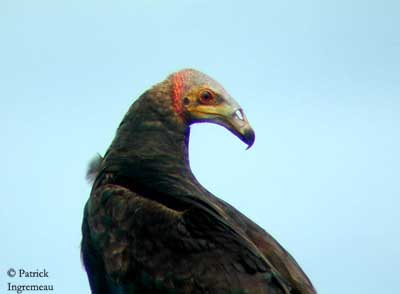
This vulture is often confused with the Greater Yellow-headed Vulture which is larger.
Both sexes are similar.
Immature is browner overall. The head is duller, rather pinkish, nape is whitish and eyes are darker.
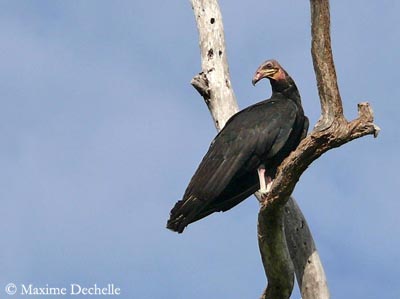
We find two subspecies which differ only in size:
C.b. burrovianus from Central America, south to C Colombia and NW Venezuela.
C.b. urubitinga from lowland South America. This one is the largest.
VOICE:
As all the Cathartids, the Lesser Yellow-headed Vulture lacks the syrinx and the associated muscles. It is almost silent and unable to utter any song or call.
However, it can produce hisses, rattles, grunts and sneezing noises. It is usually more “vocal” during the breeding season, giving series of snorts and wheezes.
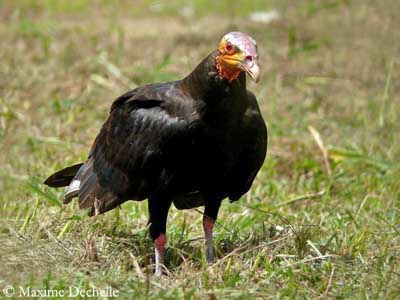
HABITAT:
The Lesser Yellow-headed Vulture frequents mainly grasslands, llanos and savannahs. But it is fairly common seasonally over the marshy areas and wanders over the dry fields and clearings.
RANGE:
The Lesser Yellow-headed Vulture occurs in Mexico, Central America and South America.
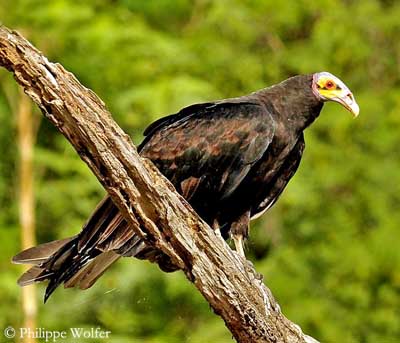
BEHAVIOUR:
The Lesser Yellow-headed Vulture is a scavenger. It feeds on carrion and carcasses, fish, amphibians, insects and other invertebrates.
This vulture has good sense of smell which allows the bird to find the food, even carcasses of very small animals such as rodents and small birds. It may catch living less active small preys too.
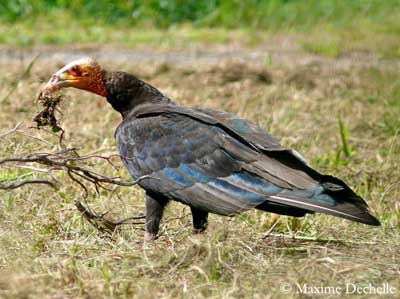
But the Lesser Yellow-headed Vulture feeds also at carcasses of large dead animal. With the Turkey Vultures and the Greater Yellow-headed Vulture, they feed more slowly than other vultures, and they usually clean up all the remaining bits of meat on the bones.
All the New World vultures have well developed sunning behaviour and we can often see them with stretched wings to the fullest extent and holding them towards the sun. This behaviour is often observed in the early morning at roost, when all the vultures expand their large wings at the same moment. They also do that throughout the day.
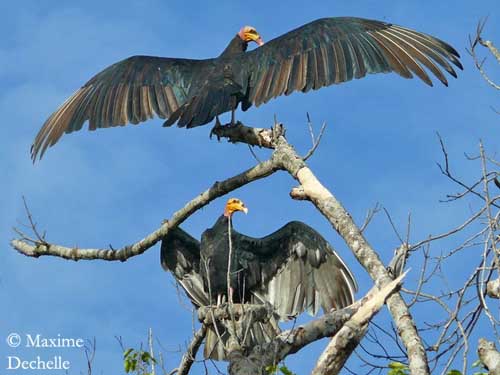
The Lesser Yellow-headed Vulture’s head colours change according to its mood. Colours become more intense to indicate the dominance, and particularly when they gather at carcasses. These changes probably play also a role during all the displays, either in courtship or in defence behaviour.
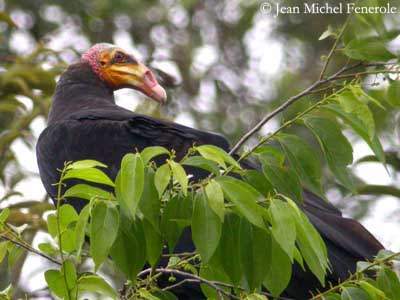
The Lesser Yellow-headed Vulture is probably sedentary in its range, performing some local movements, but sometimes travelling long distances to find food. The numbers vary seasonally in Panama and Venezuela.
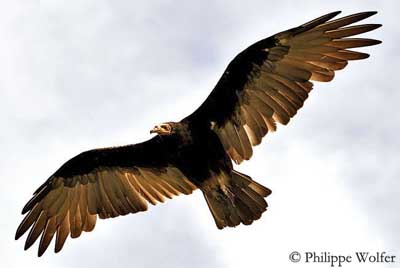
FLIGHT:
The Lesser Yellow-headed Vulture is very well adapted for soaring with the large wing surface. It uses the thermals to gain altitude, and does not flap the wings. Once it is at good height, it glides away while it slowly looses altitude, before to use another rising air.
When searching for food, it flies relatively low, a few metres above the ground.
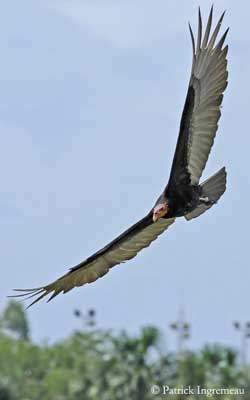
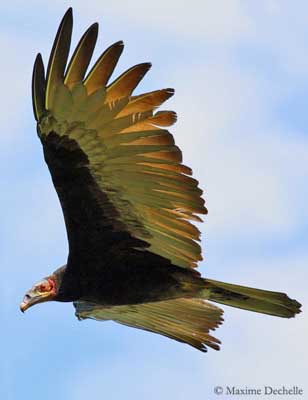
REPRODUCTION:
There is very little information about the nesting behaviour of this vulture.
The Lesser Yellow-headed Vulture nests in large tree cavities, in fallen logs or stumps. It does not build any nest, and the eggs are laid directly on the floor of the cavity.
Female lays 1-2 whitish eggs with brown markings. Incubation lasts about 40 days. The chicks are covered in thick down and are able to keep themselves warm at nest. They are fed by both parents by regurgitation during the whole nesting period. The young fledge at 2-3 months of age, or more.
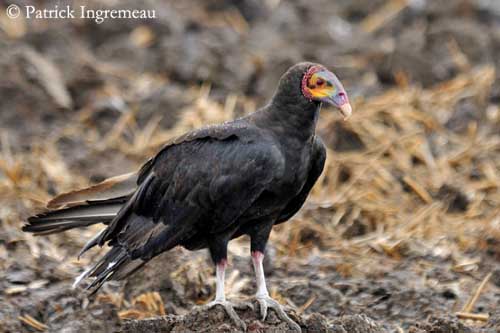
DIET:
The Lesser Yellow-headed Vulture feeds primarily on carrion located by low flight over the ground, and the good sense of smell typical in members of Cathartes genus.
It also takes small items such as fish and amphibians, insects and other invertebrates, and some less active small living preys.
At carcasses, usually the King Vulture starts by tearing open the skin of the dead animal that allows the Lesser Yellow-headed Vulture to reach the food, because it is not able to open a carcass itself with its bill. On the other hand, the King Vulture which has not good sense of smell follows it in order to find the food.
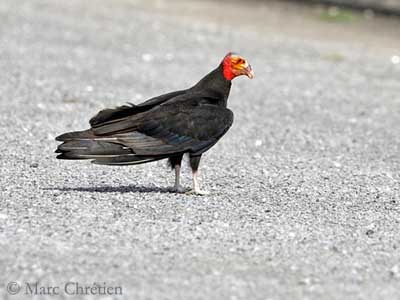
PROTECTION / THREATS / STATUS:
The Lesser Yellow-headed Vulture is widespread in open areas and populations seem to be fairly large.
It can be fairly common in suitable habitat in some parts of the range such as Panama and Colombia, and common along the coasts of French Guyana.
The main threat is the nest predation by mammals and by Ravens which steal the eggs, taking advantage of the weak nest-defence behaviour in Cathartids.
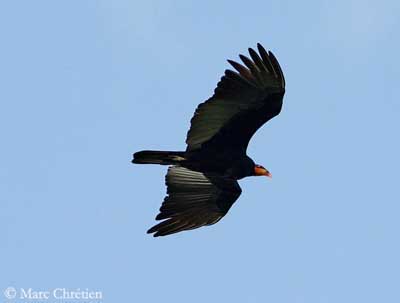
www.oiseaux-birds.com/card-lesser-yellow-headed-vulture.html
Cathartes burrovianus
Accipitriforme Order – Cathartidae Family
BIOMETRICS:
Length: 58-66 cm
Wingspan: 160 cm
Weight: 950-1550 g
DESCRIPTION:
This species is also called Savanna Vulture, and belongs to the New World vultures.
The Lesser Yellow-headed Vulture adult has blackish plumage overall, with some glossy blue-green feathers on the upperwing and distinct white area at base of the six outer primaries, forming strong contrasts against the black plumage. This pale area is due to the white quills.
Wings are long and broad and at rest, they appear longer than the tail which is relatively long and rounded.
Head and neck are bare and their colours may vary. Some birds have bright yellow bare skin, but others may also have orange and blue tones. Usually, forecrown and nape are reddish, whereas central crown is blue-grey. The skin often has warty aspect, especially on neck, nape and head sides.
The hooked bill is pale flesh to whitish with pale pink cere. Eyes are red. Legs and feet are pale greyish-white. The large nostrils allow a highly developed sense of smell in these raptors.
This vulture is often confused with the Greater Yellow-headed Vulture which is larger.
Both sexes are similar.
Immature is browner overall. The head is duller, rather pinkish, nape is whitish and eyes are darker.
We find two subspecies which differ only in size:
C.b. burrovianus from Central America, south to C Colombia and NW Venezuela.
C.b. urubitinga from lowland South America. This one is the largest.
VOICE:
As all the Cathartids, the Lesser Yellow-headed Vulture lacks the syrinx and the associated muscles. It is almost silent and unable to utter any song or call.
However, it can produce hisses, rattles, grunts and sneezing noises. It is usually more “vocal” during the breeding season, giving series of snorts and wheezes.
HABITAT:
The Lesser Yellow-headed Vulture frequents mainly grasslands, llanos and savannahs. But it is fairly common seasonally over the marshy areas and wanders over the dry fields and clearings.
RANGE:
The Lesser Yellow-headed Vulture occurs in Mexico, Central America and South America.
BEHAVIOUR:
The Lesser Yellow-headed Vulture is a scavenger. It feeds on carrion and carcasses, fish, amphibians, insects and other invertebrates.
This vulture has good sense of smell which allows the bird to find the food, even carcasses of very small animals such as rodents and small birds. It may catch living less active small preys too.
But the Lesser Yellow-headed Vulture feeds also at carcasses of large dead animal. With the Turkey Vultures and the Greater Yellow-headed Vulture, they feed more slowly than other vultures, and they usually clean up all the remaining bits of meat on the bones.
All the New World vultures have well developed sunning behaviour and we can often see them with stretched wings to the fullest extent and holding them towards the sun. This behaviour is often observed in the early morning at roost, when all the vultures expand their large wings at the same moment. They also do that throughout the day.
The Lesser Yellow-headed Vulture’s head colours change according to its mood. Colours become more intense to indicate the dominance, and particularly when they gather at carcasses. These changes probably play also a role during all the displays, either in courtship or in defence behaviour.
The Lesser Yellow-headed Vulture is probably sedentary in its range, performing some local movements, but sometimes travelling long distances to find food. The numbers vary seasonally in Panama and Venezuela.
FLIGHT:
The Lesser Yellow-headed Vulture is very well adapted for soaring with the large wing surface. It uses the thermals to gain altitude, and does not flap the wings. Once it is at good height, it glides away while it slowly looses altitude, before to use another rising air.
When searching for food, it flies relatively low, a few metres above the ground.
REPRODUCTION:
There is very little information about the nesting behaviour of this vulture.
The Lesser Yellow-headed Vulture nests in large tree cavities, in fallen logs or stumps. It does not build any nest, and the eggs are laid directly on the floor of the cavity.
Female lays 1-2 whitish eggs with brown markings. Incubation lasts about 40 days. The chicks are covered in thick down and are able to keep themselves warm at nest. They are fed by both parents by regurgitation during the whole nesting period. The young fledge at 2-3 months of age, or more.
DIET:
The Lesser Yellow-headed Vulture feeds primarily on carrion located by low flight over the ground, and the good sense of smell typical in members of Cathartes genus.
It also takes small items such as fish and amphibians, insects and other invertebrates, and some less active small living preys.
At carcasses, usually the King Vulture starts by tearing open the skin of the dead animal that allows the Lesser Yellow-headed Vulture to reach the food, because it is not able to open a carcass itself with its bill. On the other hand, the King Vulture which has not good sense of smell follows it in order to find the food.
PROTECTION / THREATS / STATUS:
The Lesser Yellow-headed Vulture is widespread in open areas and populations seem to be fairly large.
It can be fairly common in suitable habitat in some parts of the range such as Panama and Colombia, and common along the coasts of French Guyana.
The main threat is the nest predation by mammals and by Ravens which steal the eggs, taking advantage of the weak nest-defence behaviour in Cathartids.
www.oiseaux-birds.com/card-lesser-yellow-headed-vulture.html

